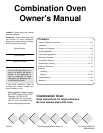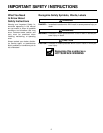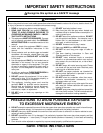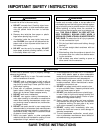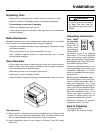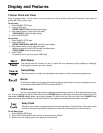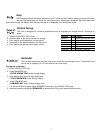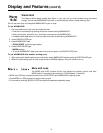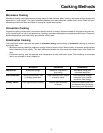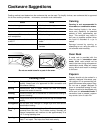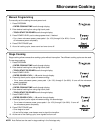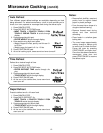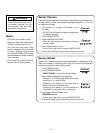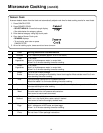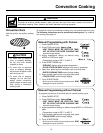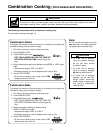
4
IMPORTANT SAFETY INSTRUCTIONS
To avoid risk of fire in the oven cavity:
a. DO NOT overcook food. Carefully attend oven
when paper, plastic, or other combustible mate-
rials are placed inside the oven to facilitate
cooking.
b. Remove wire twist-ties from paper or plastic
bags before placing bag in oven.
c. If materials inside the oven ignite, keep oven
door CLOSED, turn oven off and disconnect the
power cord, or shut off power at the fuse or cir-
cuit breaker panel.
d. DO NOT use the cavity for storage. DO NOT
leave paper products, cooking utensils, or food
in the cavity when not in use.
Liquids such as water, coffee, or tea are able to be
overheated beyond the boiling point without appear-
ing to be boiling due to surface tension of the liquid.
Visible bubbling or boiling when the container is
removed from the microwave oven is not always pre-
sent. THIS COULD RESULT IN VERY HOT LIQ-
UIDS SUDDENLY BOILING OVER WHEN A
SPOON OR OTHER UTENSIL IS INSERTED INTO
THE LIQUID. To reduce the risk of injury to persons:
1. Do not overheat the liquid.
2. Stir the liquid both before and halfway through
heating it.
3. Do not use straight-sided containers with nar-
row necks.
4. After heating, allow the container to stand in the
microwave oven for a short time before remov-
ing the container.
5. Use extreme care when inserting a spoon or
other utensil into the container.
To avoid risk of personal injury or property damage,
observe the following:
1. DO NOT deep fat fry in oven. Fat could overheat
and be hazardous to handle.
2. DO NOT cook or reheat eggs in shell or with an
unbroken yolk using microwave energy. Pressure
may build up and erupt. Pierce yolk with fork or
knife before cooking.
3. Pierce skin of potatoes, tomatoes, and similar
foods before cooking with microwave energy.
When skin is pierced, steam escapes evenly.
4. DO NOT leave oven unattended.
5. DO NOT use regular cooking thermometers in
oven when cooking in microwave or combination
mode. Most cooking thermometers contain mer-
cury and may cause an electrical arc, malfunction,
or damage to oven.
6. DO NOT use metal utensils in oven except when
recommended by microwave food manufacturers
or recipe requires metal utensils in convection or
combination mode. Heat food in containers made
of glass or china if possible.
7. Never use paper, plastic, or other combustible
materials that are not intended for cooking. If oven
temperature is high, material may ignite.
8. Oven temperature is at least 100° F in convection
mode. Verify plastic, paper or other combustible
materials are recommended by the manufacturer
to withstand the minimum oven temperature.
9. When cooking with paper, plastic, or other com-
bustible materials, follow manufacturer's recom-
mendations on product use.
10. DO NOT use paper towels which contain nylon
or other synthetic fibers. Heated synthetics could
melt and cause paper to ignite.
11. DO NOT heat sealed containers or plastic bags
in oven. Food or liquid could expand quickly and
cause container or bag to break. Pierce or open
container or bag before heating.
12. Racks, utensils, rack guides, and oven surfaces
may become hot during or after use. Use utensils
or protective clothing, like pan grips or dry oven
mitts, when necessary to avoid burns.
13. DO NOT unplug oven immediately after use.
Internal fan must cool oven to avoid damage of
electrical components.
14. To avoid pacemaker malfunction, consult physi-
cian or pacemaker manufacturer about effects of
microwave energy on pacemaker.
CAUTION
SAVE THESE INSTRUCTIONS
WARNINGWARNING



